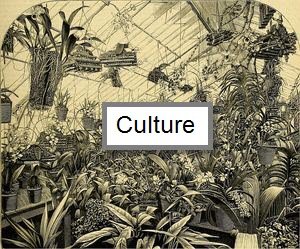Beginning with Mature Plants Offers Advantages
IT’S IRONIC THAT MOST OF US acquire our orchid plants at an immature stage, often waiting patiently for years for that first flower. Once they reach blooming size and begin to thrive, we all too frequently spend the rest of our days struggling to confine their mass to a volume we can manage. Few of us have the facilities that would allow us to grow all of our orchids to specimen size, and most would prefer to maintain several different blooming-size plants in the space it could take to grow one monstrous example. That may be good for the divisions table at your local orchid society, but not so good for those, like myself, who thrill to see large, mature orchid plants in the glory of full bloom.
Certainly those hybrids and species classified as miniatures are more manageable, and the orchids with monopodial growth habit may be a bit easier to keep as the years go by. Still, I’d wager that most orchid hobbyists (who live in temperate climates) have collections that are grown primarily in pots of 6 inches (15 cm) in diameter or less, and a remarkably small percentage of plants grown in pots with diameters of eight inches or more. Grown-up orchids, however, often seem to have vim, vigor and vitality that is unmatched by their smaller divisions, and it is unfortunate that few such specimens are seen.
CULTURAL AWARDS It is safe to say that among the AOS awards that require the greatest effort are the CCM (Certificate of Cultural Merit, 80 to 89 points) and its companion award for higher scoring specimens, the CCE (Certificate of Cultural Excellence, 90 to 100 points). These awards are a testament to the grower’s ability and do not reflect on the quality of the orchid flowers per se. Photographs and slides of these winners often elicit oohs and aahs when viewed, and in some cases, one cannot help but think the exhibitor deserved an award simply for wrestling the large plant to a site where it could be judged.
If you are considering growing some of the plants in your orchid collection to specimen size, it is wise to put a bit of thought into your selections. Vigorous growers that produce multiple leads are logical candidates. It is also smart to choose a species or hybrid that produces rather long-lasting flowers, and lots of them. For sheer impact, you may be happier with a specimen that opens its flowers simultaneously rather than sequentially. Mature orchid size varies considerably, so give some thought to how large the orchid plant you choose may eventually become.
One such plant in my collection is an example of Brassocattleya Maikai ‘Mayumi’, HCC/AOS (Brassavola nodosa × Cattleya bowringiana). Like many B. nodosa hybrids, it grows rather quickly into a specimen plant of manageable size. The flowers, for a Cattleya Alliance hybrid, are also comparatively long lasting. Mine is currently growing in a 10-inch (25-cm) pot.
Consider the growing medium and container for your specimen orchids. You do not want to have to repot such plants often, if ever. I’ve seen some beautiful specimen orchids grown in baskets, both wooden and wire, sometimes without any growing medium at all. When media is used, it should be one that deteriorates slowly. Coconut husk and tree fern outlast bark. Inert materials such as expanded clay (Aliflor) and charcoal may last years but have no nutritional value so fertilization practices must be adjusted accordingly. Smaller-scale orchid specimens can be grown on cork or tree-fern slabs. I know one grower who has produced handsome specimens in wire baskets with coir or fiber liners that were filled with rather coarse bark.
CONTAINERS If pots are used, clay has an advantage over plastic in this application because it is important that the large volume of growing medium often needed does not become soggy or stale. Even if large clay pots are used, some thought should be given to providing a mechanism for allowing the growing medium in the center of the pot to have an opportunity to dry out between waterings, or the roots in that area will surely rot. I solved the problem for my Bc. Maikai by inverting a small clay pot in the center of a 10-inch (25-cm) azalea pot before filling the larger clay pot with growing mix. The little pot provides a permanent air space that eliminates the soggy zone.
There usually comes a day when even the best-cultivated and -managed orchid specimen must be divided and repotted. Fortunately, such plants often produce large vigorous divisions that will reestablish quickly. Always remember that this is a great time to share divisions with your fellow orchid-society members and friends.
Regrettably, the award for the best-grown plant in various categories at many orchid shows is seldom much of a contest. Where are all those plants with multiple leads and inflorescences? Like many show hopefuls, I suspect some specimen plants are among those that finish flowering just before show time or open right after the event. Nevertheless, I hope everyone has a few plants selected from their collections that they are trying to grow to specimen size. With a little forethought, it is a pursuit worth the extra effort.
